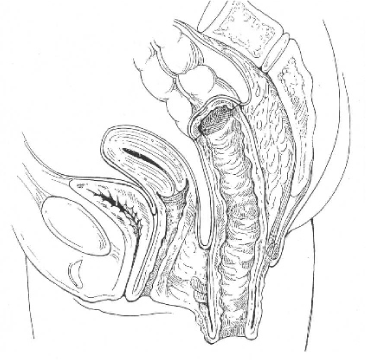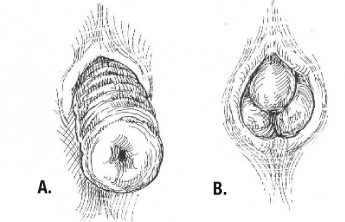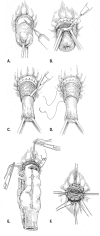Rectal prolapse: a 10-year experience
- PMID: 21603476
- PMCID: PMC3096348
Rectal prolapse: a 10-year experience
Abstract
Purpose: To compare perineal to abdominal procedures for rectal prolapse over a 10-year period at a single tertiary care institution.
Methods: Between May 1, 1995, and January 1, 2005, 75 patients underwent surgical intervention for primary rectal prolapse at a tertiary referral center. Surgical techniques included perineal-based repairs (Altemeier and Delorme procedures) and abdominal procedures (open and laparoscopic resection and/or rectopexy). Medical records were abstracted for data pertaining to patient characteristics, signs and symptoms at presentation, surgical procedure, postoperative length of hospitalization, morbidity and mortality, and recurrence of rectal prolapse.
Results: Seventy-five patients underwent surgical intervention for rectal prolapse during the study period. The average patient age was 60.8 years. Sixty-two patients (82.7%) underwent perineal-based repair (Altemeier n = 48, Delorme n = 14); eight patients (10.7%) underwent open abdominal procedures (resection and rectopexy n = 4, rectopexy only n = 4); and five patients (6.7%) underwent laparoscopic repair (laparoscopic LAR n = 3, laparoscopic resection and rectopexy n = 2). Average hospitalization was shorter with perineal procedures (2.6 days) than with abdominal procedures (4.8 days) (p < 0.0031). Postoperative complications were observed in 13.3% of cases. With a median follow-up of 39 months (range 6-123 months), there was no mortality for primary repair, a postoperative morbidity occurred in 13% of patients, and the overall rate of recurrent prolapse was 16% (16.1% for perineal-based repairs, 15.4% for abdominal procedures).
Conclusion: Perineal resections were more common, performed in significantly older patients, and resulted in a shorter hospital stay. Their minimal morbidity and similar recurrence rates make perineal procedures the preferred option.
Keywords: Altemeier; Delorme; Rectal prolapse; procedentia; recurrence.
Figures







References
-
- Boutsis C., Ellis H. The Ivalon-sponge wrap operation for rectal prolapse: An experience with 26 patients. Dis Colon Rectum. 1974;17:21–37. - PubMed
-
- Steele S. R., Goetz L. H., Minami S., Madoff R. D., Mellgren A. F., Parker S. C. Management of recurrent rectal prolapse: surgical approach influences outcome. Dis Colon Rectum. 2006;49:440–445. - PubMed
-
- Nigro N. D. An evaluation of the cause and mechanism of complete rectal prolapse. Dis Colon Rectum. 1966;9:391–398. - PubMed
-
- Madiba T. E., Baig M. K., Wexner S. D. Surgical management of rectal prolapse. Arch Surg. 2005;140:63–73. - PubMed
-
- Corman M. L. Colon and Rectal Surgery, 5th ed. 2005. ed. Philadelphia: Lippincott Williams & Wilkins.
LinkOut - more resources
Full Text Sources
Miscellaneous
